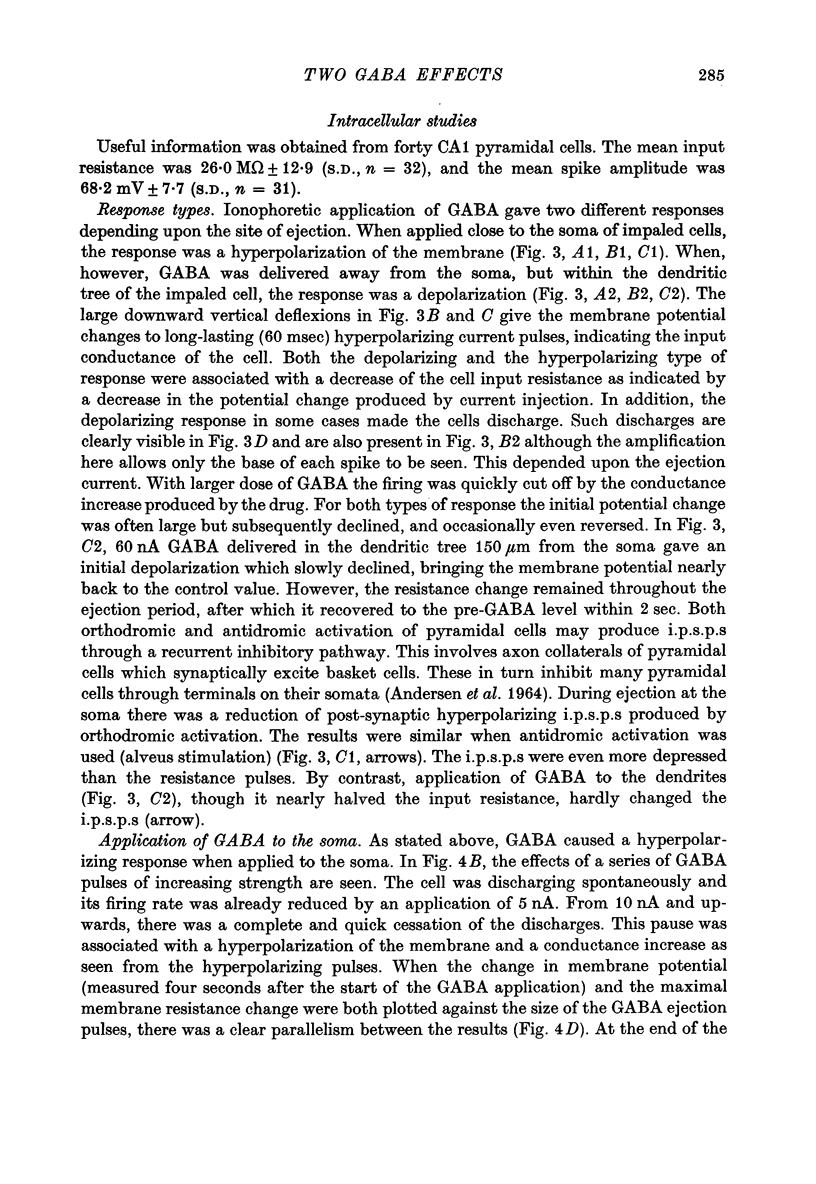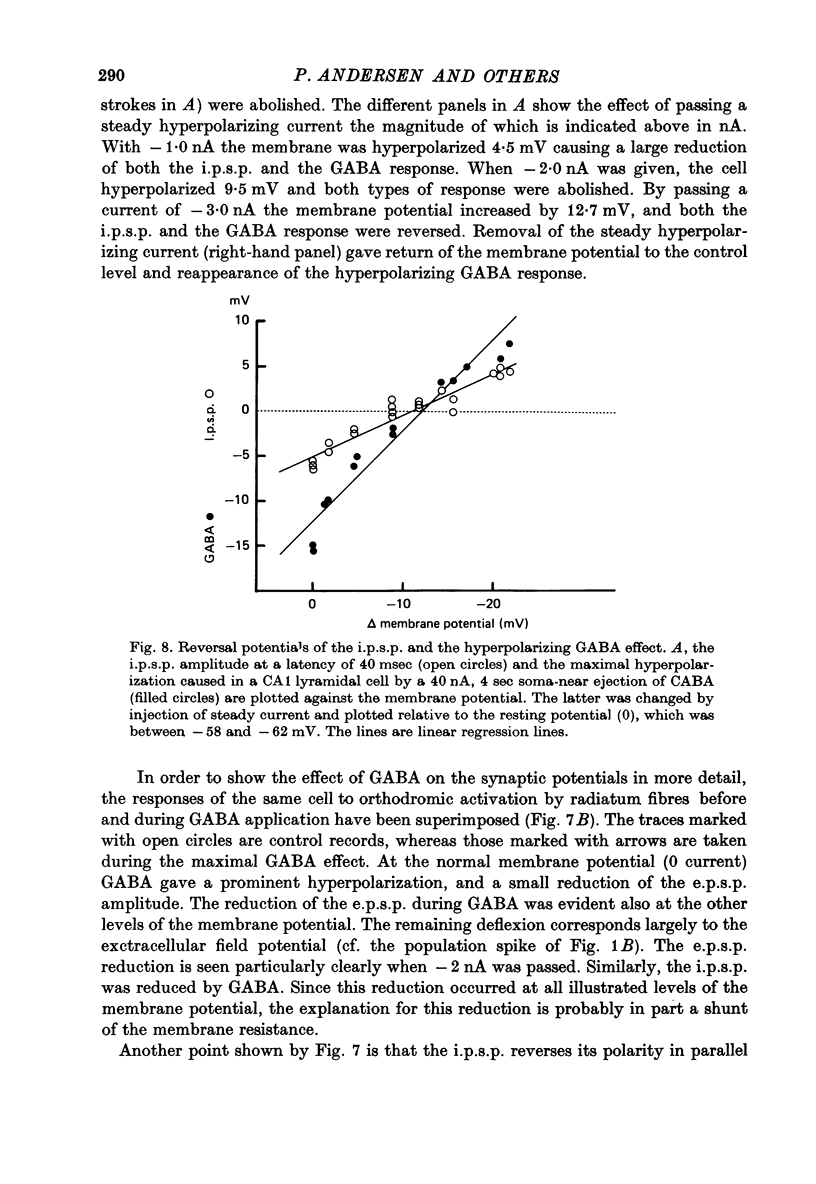Abstract
1. Extra- and intracellular recordings were made from CA1 cells in hippocampal slices in vitro. The effects of ionophoretically applied GABA on somatic and dendritic regions were studied. 2. Ionophoresis of GABA at dendritic sites gave a reciprocal effect by inhibiting the effect of excitatory synapses close to the dendritic application, while facilitating those lying further away. For example, GABA delivered to the mid-radiatum dendritic region reduced the population spike generated by a radiatum volley, while facilitating the population spike evoked by oriens fibre stimulation. Similarly, when single cells were recorded from, mid-apical dendritic delivery of GABA abolished the synaptically driven discharges evoked by fibres terminating at this part of the dendritic tree, but facilitated the responses to input from fibres terminating on the basal dendrites of the same cell. 3. With intracellular recording two effects were observed. Applied near the soma, GABA induced a hyperpolarization associated with an increased membrane conductance. When applied to dendrites, GABA caused a depolarization also associated with an increased membrane conductance. Both types of GABA applications could inhibit cell discharges, although in some cases the depolarizing response could facilitate other excitatory influences or cause cell firing by itself. 4. Both the hyperpolarizing and depolarizing GABA responses persisted after blockade of synaptic transmission by applying a low calcium high magnesium solution, indicating mediation via a direct effect upon the cell membrane. 5. The reversal potential for the hyperpolarizing GABA effect was similar to the equilibrium potential for the i.p.s.p. evoked from alveus or orthodromically, and was 10-12 mV more negative than the resting potential. The size of the depolarizing response was also dependent upon the membrane potential. By extrapolation an estimated equilibrium potential was calculated as about -40 mV. 6. Our results support the idea that the hyperpolarizing basket cell inhibition at the soma is mediated by the release of GABA. This hyperpolarizing response causes a general inhibition of firing. The dendritic effects of GABA, however, seem to represent another type of inhibition, which by shunting synaptic currents makes possible a selective inhibitory influence on afferents synapsing locally while facilitating more remotely placed excitatory synapses. We propose the term discriminative inhibition for this postulated new type of control of pyramidal cell discharges.
Full text
PDF

















Selected References
These references are in PubMed. This may not be the complete list of references from this article.
- ANDERSEN P., ECCLES J. C., LOYNING Y. PATHWAY OF POSTSYNAPTIC INHIBITION IN THE HIPPOCAMPUS. J Neurophysiol. 1964 Jul;27:608–619. doi: 10.1152/jn.1964.27.4.608. [DOI] [PubMed] [Google Scholar]
- Alger B. E., Nicoll R. A. GABA-mediated biphasic inhibitory responses in hippocampus. Nature. 1979 Sep 27;281(5729):315–317. doi: 10.1038/281315a0. [DOI] [PubMed] [Google Scholar]
- Allen G. I., Eccles J., Nicoll R. A., Oshima T., Rubia F. J. The ionic mechanisms concerned in generating the i.p.s.ps of hippocampal pyramidal cells. Proc R Soc Lond B Biol Sci. 1977 Sep 19;198(1133):363–384. doi: 10.1098/rspb.1977.0103. [DOI] [PubMed] [Google Scholar]
- Andersen P., Silfvenius H., Sundberg S. H., Sveen O. Effects of remote dendritic synapses on hippocampal pyramids [proceedings]. J Physiol. 1977 Mar;266(1):100P–100P. [PubMed] [Google Scholar]
- Barker J. L., Ransom B. R. Amino acid pharmacology of mammalian central neurones grown in tissue culture. J Physiol. 1978 Jul;280:331–354. doi: 10.1113/jphysiol.1978.sp012387. [DOI] [PMC free article] [PubMed] [Google Scholar]
- Biscoe T. J., Straughan D. W. Micro-electrophoretic studies of neurones in the cat hippocampus. J Physiol. 1966 Mar;183(2):341–359. doi: 10.1113/jphysiol.1966.sp007869. [DOI] [PMC free article] [PubMed] [Google Scholar]
- Curtis D. R., Duggan A. W., Felix D., Johnston G. A., McLennan H. Antagonism between bicuculline and GABA in the cat brain. Brain Res. 1971 Oct 8;33(1):57–73. doi: 10.1016/0006-8993(71)90305-2. [DOI] [PubMed] [Google Scholar]
- Curtis D. R., Felix D., McLellan H. GABA and hippocampal inhibition. Br J Pharmacol. 1970 Dec;40(4):881–883. doi: 10.1111/j.1476-5381.1970.tb10663.x. [DOI] [PMC free article] [PubMed] [Google Scholar]
- Deschenes M., Feltz P., Lamour Y. A model for an estimate in vivo of the ionic basis of presynaptic inhibition: an intracellular analysis of the GABA-induced depolarization in rat dorsal root ganglia. Brain Res. 1976 Dec 24;118(3):486–493. doi: 10.1016/0006-8993(76)90318-8. [DOI] [PubMed] [Google Scholar]
- Dingledine R., Gjerstad L. Reduced inhibition during epileptiform activity in the in vitro hippocampal slice. J Physiol. 1980 Aug;305:297–313. doi: 10.1113/jphysiol.1980.sp013364. [DOI] [PMC free article] [PubMed] [Google Scholar]
- Eccles J., Nicoll R. A., Oshima T., Rubia F. J. The anionic permeability of the inhibitory postsynaptic membrane of hippocampal pyramidal cells. Proc R Soc Lond B Biol Sci. 1977 Sep 19;198(1133):345–361. doi: 10.1098/rspb.1977.0102. [DOI] [PubMed] [Google Scholar]
- Gallagher J. P., Higashi H., Nishi S. Characterization and ionic basis of GABA-induced depolarizations recorded in vitro from cat primary afferent neurones. J Physiol. 1978 Feb;275:263–282. doi: 10.1113/jphysiol.1978.sp012189. [DOI] [PMC free article] [PubMed] [Google Scholar]
- Nicoll R. A. The blockade of GABA mediated responses in the frog spinal cord by ammonium ions and furosemide. J Physiol. 1978 Oct;283:121–132. doi: 10.1113/jphysiol.1978.sp012491. [DOI] [PMC free article] [PubMed] [Google Scholar]
- Nishi S., Minota S., Karczmar A. G. Primary afferent neurones: the ionic mechanism of GABA-mediated depolarization. Neuropharmacology. 1974 Mar;13(3):215–219. doi: 10.1016/0028-3908(74)90110-5. [DOI] [PubMed] [Google Scholar]
- Ribak C. E., Vaughn J. E., Saito K. Immunocytochemical localization of glutamic acid decarboxylase in neuronal somata following colchicine inhibition of axonal transport. Brain Res. 1978 Jan 27;140(2):315–332. doi: 10.1016/0006-8993(78)90463-8. [DOI] [PubMed] [Google Scholar]
- Skrede K. K., Westgaard R. H. The transverse hippocampal slice: a well-defined cortical structure maintained in vitro. Brain Res. 1971 Dec 24;35(2):589–593. doi: 10.1016/0006-8993(71)90508-7. [DOI] [PubMed] [Google Scholar]
- Storm-Mathisen J., Fonnum F. Quantitative histochemistry of glutamate decarboxylase in the rat hippocampal region. J Neurochem. 1971 Jun;18(6):1105–1111. doi: 10.1111/j.1471-4159.1971.tb12039.x. [DOI] [PubMed] [Google Scholar]


